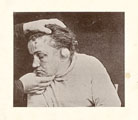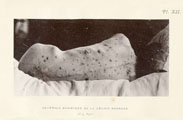










Paris : Félix Alcan, Editeur; Ancienne Librairie Germer Baillière et Cie., 1890.
Description : vii., 636 p. ; ill.: 11 photo., 1 lith. ; 24.5 cm.
Photographs : 11 mounted photographs.
Photographer: Albert Londe (attribution of Cabinet A & M).
Subject: neurology, epilepsy.
A monumental undertaking by an important member of the Charcot circle, this volume is a synopsis of all that was understood and documented on neurologic disorders up to the time of its publication in 1890. Féré cites case histories and observations from over 800 physicians and presents his own classification of hystero-epileptic disorders, but curiously, he does not cite Paul Richer whose magnum opus entitled Études cliniques sur l’hystéro-épilepsie ou hystérie was first published in 1881 with a preface written by Charcot and which extrapolated Charcot's theories on the subject to include famous religious ecstatics such as Louise Lateau.
By referring to this reproduction of André Brouillet's painting entitled Une leçon clinique à la Salpêtrière, Féré can be observed seated next to Paul Richer and both men are shown to be fixedly watching the great Charcot as he uses hypnosis on his patient Blanche Wittmann so as to demonstrate before an audience of proteges his theory for an organic basis of neurosis. Brouillet painted his tableau in 1886, the year of publication for Le magnetisme animal which Féré co-wrote with Binet soon after he met Binet and procured for him a position at Salpêtrière in 1883. Blanche Wittman is also the patient Féré and Binet presented to support their theory of the transference of a morbid symptomology from one part of the body to another by using magnets. However, the book was refuted by the scientific community most notably in an attack from the (school of) Nancy physicians Liebault and Bernheim who were probably opportunists in their rebuke and aiming for Charcot.
Chastened by the criticism, Binet left Salpêtrière. Féré who had served Charcot as secrétaire and chef de laboratoire took a position at Bicêtre and probably thought to distance himself from his mentor, however he pretty much remains loyal to the organic theory of mental disease at least with this book, writing:
On peut, comme nous le verrons, reconnaitre aux épilepsies des causes déterminantes très diverses; mais ces causes ne peuvent agir que lorsqu'il existe une condition prédisposante congenitale ou acquise.
One can recognize, as we shall see, very diverse determining causes for the epilepsies; but these causes can act only when there is a predisposing congenital or acquired condition.
Féré also offers a mild criticism of Bernheim's claim to a cure of epilepsy through hypnosis; writing that his cure was only for the "épileptiformes" of the disease which often appear (and disappear) following a cranial trauma.
Referring again to Brouillet's painting, the photographer Albert Londe can be observed seated to the far left. It is my belief that Féré would have availed himself of the services of Londe and the photographic laboratories he established at the Salpêtrière for the images which illustrate this volume. An éminence distingué, Londe was integral to the research production that came out of the Salpêtrière during Charcot's tenure and it is a tribute to the stewardship of Charcot that he gathered around him not only the brightest minds of science, but artists and photographers as well, according them the same collegiality he extended to his researchers. Albert Londe's name is given a place of honor as one of the editors for the most important organ of the Charcot researchers, namely the Nouvelle Iconographie de la Salpêtrière which was published bimonthly from 1888 to 1910.











